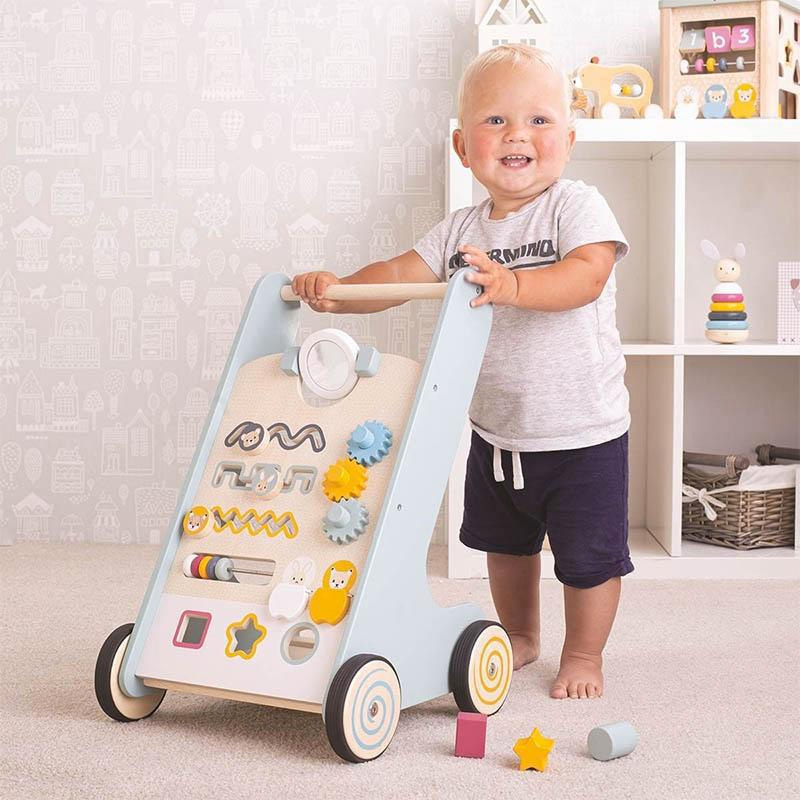“7 techniques to improve toddler’s walking balance” is a collaborative post.
The act of walking is a milestone for toddlers. This challenging task requires muscular power, synchronicity, and equilibrium. Toddlers must establish great walking balance early on to promote mobility and independence. It enhances confidence, cognitive abilities, and environmental awareness. It boosts their physical abilities.
Despite this, many toddlers require help walking and keeping balance. This article will discuss ways to improve a child’s walking balance. This article provides extensive methods for improving your child’s walking balance.
Use a push toy or baby walker
Push toys and baby walkers are fantastic tools to significantly improve a toddler’s walking balance. Wooden baby walkers or push toys with four wheels can support and stabilise the toddler as they take their first steps. You can find the best wooden baby walkers exclusively at My Happy Helpers.
They provide a sturdy support system that encourages the child to stand upright, enhancing their posture and leg muscles. It’s like having a moving handrail that provides the necessary support while allowing toddlers to explore their surroundings.
The trick is to select a push toy or walker suitable for your child’s height and weight. It should be sturdy enough to support them but light enough for them to push without too much effort. This balance allows them to focus on their walking technique rather than struggling with a heavy object. When they push the toy or walker, they engage their core and lower body muscles, which are crucial for maintaining balance.
Encourage barefoot walking
Encouraging your toddler to walk barefoot can significantly boost their balance and coordination skills. When children walk without shoes, their feet come into direct contact with the ground, allowing them to feel various textures and temperatures. This sensory feedback helps them understand how different surfaces affect their stability, teaching them to adjust their balance accordingly.
Walking barefoot strengthens the muscles and ligaments in the feet, promoting better balance and reducing the risk of future foot problems. It also enhances the child’s proprioception, the sense of knowing where one’s body is in space. This awareness is crucial for maintaining balance and coordinating movements.
Engaging in physical games
Physical games are an excellent way to enhance a toddler’s balance while ensuring they’re having fun. Games that involve running, jumping, or even dancing can help your child improve their coordination, muscle strength, and, ultimately, their walking balance.
Consider games like ‘Follow the Leader,’ where your toddler has to mimic your movements. This game engages them physically and mentally as they must observe and remember their actions.
Another great game is ‘Balancing Beam,’ you can use a line on the floor or a wood plank, and the child has to walk along without stepping off. This game directly targets their balance skills.

Practice balance-building exercises
Balance-building exercises are a fantastic way to improve your toddler’s walking abilities. Think of it as a fun workout session that your little one can enjoy while enhancing their balance and coordination.
One simple but effective exercise is the ‘One Leg Stand.’ Have your child stand on one foot, helping them maintain their balance if needed. Challenge them to lift their foot higher or hop on one leg as they get comfortable. This exercise strengthens the leg muscles and improves stability.
Another great exercise is the ‘Tippy Toe Walk.’ Encourage your toddler to walk around the room on their tiptoes. It strengthens their calf muscles and helps them understand how weight shifting affects their balance.
Remember, these exercises should be enjoyable for the child. Keep the sessions short, playful, and full of encouragement and praise.
Avoid jumpers and excessive bouncers
While jumpers and bouncers might seem fun for your toddler, excessive use can hinder their balance development. These devices support the child in an upright position, giving them the illusion of walking or jumping without engaging the necessary muscles.
Over-dependence on these tools can delay the development of motor skills required for independent walking. Using these devices sparingly is best to focus more on activities that encourage natural walking and balancing skills.
Walking on uneven surfaces
Walking on uneven surfaces can be a thrilling adventure for your toddler and a powerful tool for balance improvement. Different surfaces provide varying degrees of stability, challenging your child to adapt their balance accordingly.
You could start with something simple like a soft carpet, then gradually introduce grassy terrain, a sandy beach, or even a safe, rocky path. Always ensure your toddler’s safety during these explorations. Hold their hand if needed, especially when trying a new surface.
Provide a safe environment
When it comes to improving your toddler’s walking balance, the environment plays a crucial role. A safe, open space allows the child to explore and practice their walking skills without fear of injury.
Remove hazards such as sharp objects, slippery rugs, or unstable furniture. Provide soft landing spots (like pillows or cushions) around areas where they frequently practice walking. It can help prevent injuries if they lose their balance and fall.
Conclusion
Improving a toddler’s walking balance is a process that requires patience, consistency, and creativity. As parents or caregivers, you can shape this learning journey, turning daily activities into engaging balance-building exercises. Remember, it’s not about rushing the process but encouraging gradual and steady progress.
The use of push toys or walkers, barefoot walking, engaging in physical games, balance-building exercises, moderation in using jumpers and bouncers, encouraging walks on uneven surfaces, and providing a safe environment all enhance your toddler’s balance and coordination skills. These strategies are beneficial in the short term for their walking abilities and form the foundation for a lifetime of physical strength and agility.
As always, your child’s safety should be paramount. Never leave them unattended during these activities. Always ensure they’re exploring in a safe, hazard-free area.






